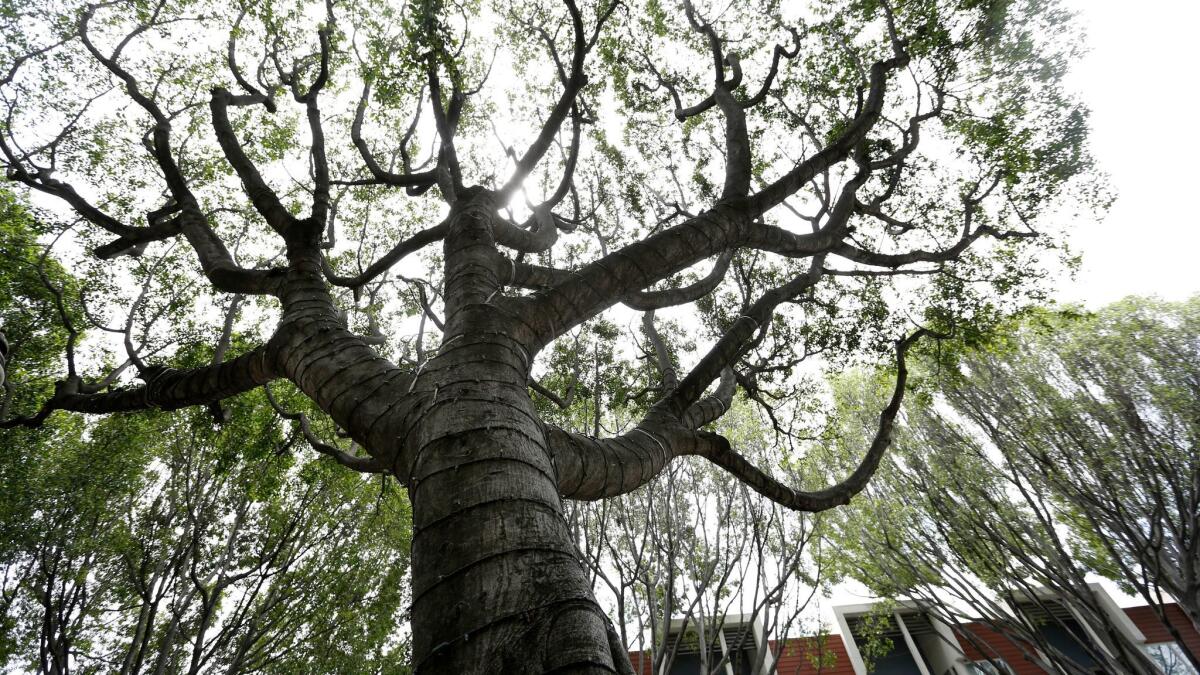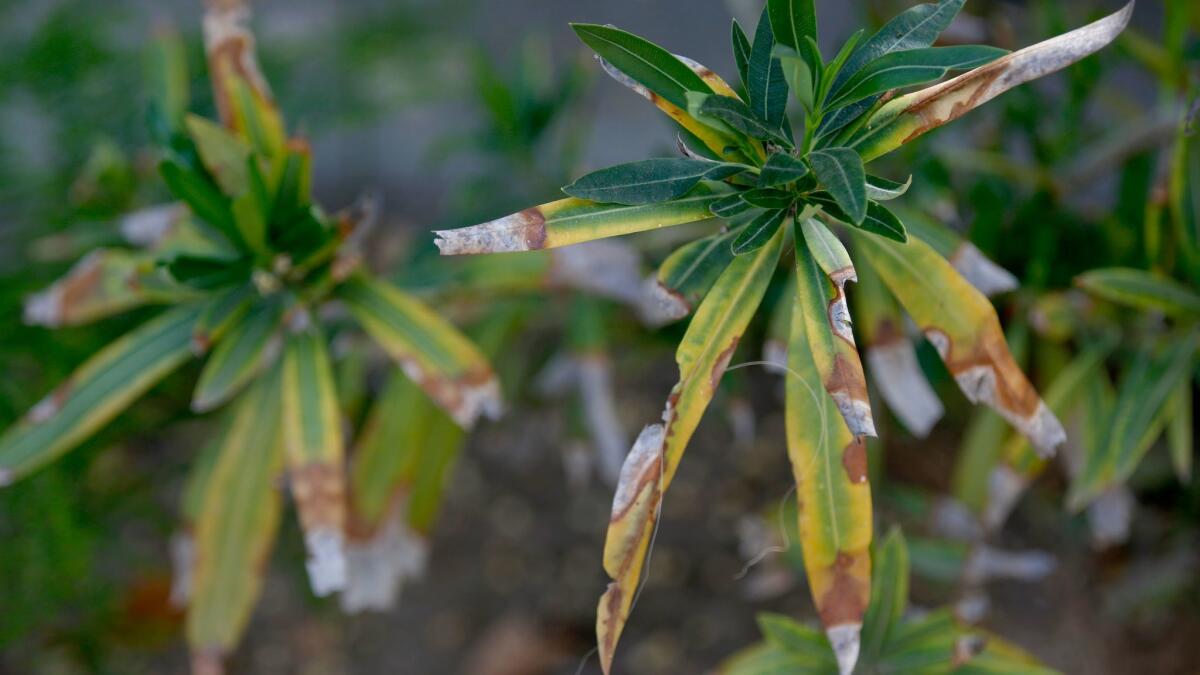Insects and disease are ravaging the Southland’s urban trees. Who’s going to stop them?

- Share via
Insects and disease are killing an unprecedented number of Southern California’s urban trees, but each day on his way to work, Los Angeles County plant pathologist Jerrold Turney sees opportunity amid the biological nightmare.
On the drive between his home in South Pasadena and his laboratory in South Gate, he takes stock of the survivors, the trees that offer some hope to the region.
“There’s dead and dying liquidambars, oleanders and olives almost everywhere you look,” he said, backing his car out of the driveway.
“Sycamores and plums? Forget it.” He snapped his fingers. “They go like that.
“But there are winners out there too,” he said. “Ginkgoes, Southern magnolias, pink trumpets, pepper and pines are hanging in there. I would even recommend replanting with pecans, if you’ve got room for those huge trees.”
Amid the devastation, the race has begun to develop new lists of stronger, less vulnerable trees.
It’s a first step in trying to reconstruct the treescape of Los Angeles and surrounding communities, which is withering under a deadly confluence of invasive pests, prolonged drought and climate change.
An estimated 27 million trees are at risk of infestation in Los Angeles, Orange, Riverside and San Bernardino counties, including parts of the desert. That’s roughly 38% of the 71 million trees in the 4,244-square-mile urban region with a population of about 20 million people.
The polyphagous shot hole borer and its cousin, the Kuroshio shot hole borer, are known to transmit a fatal fungal disease in 64 species of trees across Southern California, including willows, avocados, palo verdes, sycamores and Japanese maples.
The goldspotted oak borer has killed tens of thousands of drought-stressed oak trees from San Diego County to Los Angeles County. The aphid-size Asian citrus psyllid is transferring an incurable bacterial disease as it feasts on citrus leaves. Oleander leaf scorch is an incurable bacterial disease spread by the glassy-winged sharpshooter, a flying insect. The South American palm weevil threatens palms throughout the region.

So far, state and local government agencies have been slow to react with plans to address the devastation, which stands to significantly change the way Southern California looks, feels and smells and the way Southern Californians live.
Part of the problem is a lack of knowledge about how many trees have been attacked and how likely it is that some species will rebound.
Methods to reduce the threat posed by the onslaught of pests, many of them new arrivals with poorly understood life cycles, are the focus of debates among research scientists, arborists and urban planners.
The Los Angeles Bureau of Street Services, which is responsible for trees in the city’s public right-of-ways, relies on a tree inventory compiled in 1996. It stopped planting trees in 2008 because of budget cuts, and it limits its services to removal of dead, dying or hazardous trees.
We need to start dressing up our communities with trees suited for the future climate we are transitioning into.
— Jonathan Parfrey, executive director, Climate Resolve
Yet without an accurate inventory, it is all but impossible for the agency to devise a plan to protect its trees from invasive, fast-spreading insects, according to a report conducted in 2015.
In San Diego County, officials contend green leaves on the sprouts of 144,000 willows in Tijuana River Valley Regional Park attacked by shot hole borer beetles last year show they are growing back at a fast pace.
Akif Eskalen, a plant pathologist at UC Riverside, however, says that when those sprouts grow larger than 1 inch in diameter, the beetles will bore into them too.
Such disagreements, he said, can complicate efforts to obtain funding and approvals for research needed to develop a response to the devastating insect attacks.
The cost of removing and replacing the 27 million trees at risk of infestation by the most destructive threat, polyphagous shot hole borers, would exceed $36 billion if all were to die, according to a study by Greg McPherson, a research forester with the U.S. Forest Service.
Cities and counties spending heavily on removing troubled trees within their jurisdictions are prohibited from assisting private property owners, who must pay commercial operators an average of $1,000 per large tree to clear the deadwood.
Meanwhile, the race is on to develop new lists of trees that are less susceptible to invasive pests, prolonged drought and climate change.
The look of Southern California’s green canopies has changed several times over the past two centuries. Untold numbers of native oaks and sycamores fell in the 1800s to ranchers eager to expand grazing land. In the 1950s and ’60s, developers turned their noses up at those species, landscaping their subdivisions instead with huge numbers of nonnative trees, including palms, crape myrtles, olives and liquidambars, also known as American sweet gum.
This time around, planners hope to learn from the region’s mistakes.
“We need to start dressing up our communities with trees suited for the future climate we are transitioning into,” said Jonathan Parfrey, executive director of the environmental nonprofit Climate Resolve.

Sycamores, purple leaf plum, liquidambars and olive trees already have fallen off the list of trees recommended by City Plants, a city of Los Angeles agency that provides free trees to residents and plants street trees. Instead, it has increased plantings of black acacia, African sumac and Brisbane box trees, among other hardy species.
Turney, the plant pathologist, has made a habit of taking deliberately circuitous routes to work in the interest of making informal spot checks of the damage.
Some of the hardest hit areas include the city of Pasadena, home of the Rose Parade and winner of this year’s “Tree City USA” honor by the National Arbor Day Foundation; Alhambra; Arcadia; Claremont; and South Pasadena, Turney said.
“I understand the concern in peoples’ voices when they ask: ‘How can I save my trees? What can I replace them with?’” Turney said.
Less than a mile from his home, Turney brought his car to an abrupt stop along a broad street median in Alhambra dominated by rows of ficus microcarpa more than 50 feet tall. “Let’s go for a walk,” he said.
Moments later, he was striding beneath the boughs of the trees that had lost most of their leaves from a fungal disease that had coated their branches with a sooty residue.
“Just a few years ago, this was one of the prettiest streets in California,” he said. “Now, it’s going to cost Alhambra a chunk of money to rip out all these trees. And once they’re gone, nearby residents can expect to see their monthly electricity bills rise by 20% because it will be harder to keep their houses cool in summer without the shade.”
In Alhambra’s nearby historic and tidy Emery Park Hills neighborhood, Maria Luz, 66, like many of her neighbors, opted to save some money by paying a commercial arborist to trim, rather than remove, three 20-foot-tall liquidambars stricken with what she described as “a plague.”
There’s dead and dying liquidambars, oleanders and olives almost everywhere you look.
— Jerrold Turney, Los Angeles County plant pathologist
“The arborist said if we only trim, we could keep them around awhile longer,” Luz said in Spanish. “Otherwise, it would have cost us $300 to remove each tree, plus more money to grind up the stumps.”
A few miles away, in Pasadena, self-employed recycler Ernesto Cousin, 57, was methodically emptying the water remaining in plastic bottles he’d plucked out of local trash bins onto the base of a ficus tree.
“Looks like it could use some help,” he said.
“I remember when all these trees were so thick and full of life you couldn’t see the sky above them,” he said. “Now, they don’t look so good, and most people around here blame it on the drought. But it’s not that. Something else is wrong.
“I’m going to help them in any way I can,” he said, “until there’s not one leaf left on their branches.”
ALSO
Central California towns in trouble if Sierra snowpack melts too fast
Researchers test a possible drought solution by flooding an almond farm
Opinion: Non-native plants won’t save L.A. from the beetle that’s killing its trees
More to Read
Sign up for Essential California
The most important California stories and recommendations in your inbox every morning.
You may occasionally receive promotional content from the Los Angeles Times.











